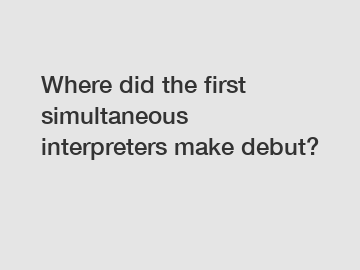Where did the first simultaneous interpreters make debut?
Where did the first simultaneous interpreters make their debut?
The first simultaneous interpreters made their debut at the Nuremberg Trials after World War II. This groundbreaking event marked a significant milestone in the history of interpretation and had a profound impact on subsequent international conferences and diplomatic activities.
The origins of simultaneous interpretation can be traced back to the need for effective communication during the Nuremberg Trials. With delegates from different countries gathering to prosecute and bring justice to those responsible for war crimes, it was essential to bridge the language barrier. Traditional consecutive interpretation, where the speaker pauses after a sentence or two to allow the interpreter to translate, proved to be time-consuming and disrupted the flow of proceedings. As a result, a team of interpreters led by Colonel Léon Dostert developed and implemented simultaneous interpretation for the first time.

The impact of the first simultaneous interpreters' debut extends beyond the immediate circumstances of the Nuremberg Trials. The success and effectiveness of this new method prompted its adoption at subsequent international conferences, such as the United Nations General Assembly. Simultaneous interpretation became the standard practice for multilingual events, facilitating cross-cultural dialogue and diplomatic interactions across the globe.
This innovation in interpretation not only revolutionized the way international conferences were conducted but also had implications for global diplomacy. The newfound ability to comprehend and exchange ideas in real-time eliminated communication barriers, fostering better understanding and cooperation among diplomatic representatives. It promoted mutual respect and facilitated negotiations, ultimately contributing to the maintenance of peaceful relations and the resolution of global conflicts.
In conclusion, the first simultaneous interpreters made their debut at the Nuremberg Trials, marking a significant milestone in the history of interpretation. The development and implementation of simultaneous interpretation at this international event revolutionized the field, leading to its widespread adoption in subsequent conferences and diplomatic activities. This innovative approach has had a profound impact, streamlining communication, promoting cross-cultural dialogue, and facilitating global diplomacy.
For more information, please visit conference room audio and video equipment, Conference Room Audio Video Solutions, conference room audio video system.


